It's not good idea to use server resources to track changes in such scenarios. In scenarios like shopping basket, list or batch editing it's better track changes at client-side.
Your requirement to get Views generated at server-side doesn't mean you need to track changes in DbContext. Get the index view and create view from server, but track changes on client. Then to save, post all data to the server to save changes based on the tracking info that you have.
The mechanism for client-side change tracking depends to the requirement and the scenario, for example you can track changes using html inputs, you can track changes using cookie, you can track changes using javascript objects in browser memory like angular scenarios.
Here is this post I'll show an example using html inputs and model binding. To learn more about this topic, take a look at this article by Phill Haack: Model Binding To A List.
Example
In the following example I describe a list editing scenario for a list of customers. To make it simple, I suppose:
- You have a list of customers which you are going to edit at client. You may want to add, edit or delete items.
- When adding new item, the row template for new row should come from server.
- When deleting, you mark an item as deleted by clicking on a checkbox on the row.
- When adding/editing you want to show validation errors near the cells.
- You want to save changes at the end, by click on Save button.
To implement above scenario Then you need to create following models, actions and views:
Trackable<T> Model
This class is a model which helps us in client side tracking and list editing:
public class Trackable<T>
{
public Trackable() { }
public Trackable(T model) { Model = model; }
public Guid Index { get; set; } = Guid.NewGuid();
public bool Deleted { get; set; }
public bool Added { get; set; }
public T Model { get; set; }
}
Customer Model
The customer model:
public class Customer
{
[Display(Name ="Id")]
public int Id { get; set; }
[StringLength(20, MinimumLength = 1)]
[Required]
[Display(Name ="First Name")]
public string FirstName { get; set; }
[StringLength(20, MinimumLength = 1)]
[Required]
[Display(Name ="Last Name")]
public string LastName { get; set; }
[EmailAddress]
[Required]
[Display(Name ="Email Name")]
public string Email { get; set; }
}
Index.cshtml View
The Index view is responsible to render List<Trackable<Customer>>. When rendering each record, we use RowTemplate view. The same view which we use when adding new item.
In this view, we have a submit button for save and a button for adding new rows which calls Create action using ajax.
Here is Index view:
@model IEnumerable<Trackable<Customer>>
<h2>Index</h2>
<form method="post" action="Index">
<p>
<button id="create">New Customer</button>
<input type="submit" value="Save All">
</p>
<table class="table" id="data">
<thead>
<tr>
<th>
Delete
</th>
<th>
@Html.DisplayNameFor(x => x.Model.FirstName)
</th>
<th>
@Html.DisplayNameFor(x => x.Model.LastName)
</th>
<th>
@Html.DisplayNameFor(x => x.Model.Email)
</th>
</tr>
</thead>
<tbody>
@foreach (var item in Model)
{
await Html.RenderPartialAsync("RowTemplate", item);
}
</tbody>
</table>
</form>
@section Scripts{
<script>
$(function () {
$('#create').click(function (e) {
e.preventDefault();
$.ajax({
url: 'Create',
method: 'Get',
success: function (data) {
$('#data tbody tr:last-child').after(data);
},
error: function (e) { alert(e); }
});
});
});
</script>
}
RowTemplate.cshtml View
This view is responsible to render a customer record. In this view, we first render the Index in a hidden, then set a prefix [index] for the fields and then render the fields, including index again, added, deleted and model id:
Here is RowTemplate View:
@model Trackable<Customer>
<tr>
<td>
@Html.HiddenFor(x => x.Index)
@{Html.ViewData.TemplateInfo.HtmlFieldPrefix = $"[{Model.Index}]";}
@Html.HiddenFor(x => x.Index)
@Html.HiddenFor(x => x.Model.Id)
@Html.HiddenFor(x => x.Added)
@Html.CheckBoxFor(x => x.Deleted)
</td>
<td>
@Html.EditorFor(x => x.Model.FirstName)
@Html.ValidationMessageFor(x => x.Model.FirstName)
</td>
<td>
@Html.EditorFor(x => x.Model.LastName)
@Html.ValidationMessageFor(x => x.Model.LastName)
</td>
<td>
@Html.EditorFor(x => x.Model.Email)
@Html.ValidationMessageFor(x => x.Model.Email)
</td>
</tr>
CustomerController
public class CustomerController : Controller
{
private static List<Customer> list;
}
It will have the following actions.
[GET] Index Action
In this action you can load data from database and shape it to a List<Trackable<Customer>> and pass to the Index View:
[HttpGet]
public IActionResult Index()
{
if (list == null)
{
list = Enumerable.Range(1, 5).Select(x => new Customer()
{
Id = x,
FirstName = $"A{x}",
LastName = $"B{x}",
Email = $"A{x}@B{x}.com"
}).ToList();
}
var model = list.Select(x => new Trackable<Customer>(x)).ToList();
return View(model);
}
[GET] Create Action
This action is responsible to returning new row template. It will be called by a button in Index View using ajax:
[HttpGet]
public IActionResult Create()
{
var model = new Trackable<Customer>(new Customer()) { Added = true };
return PartialView("RowTemplate", model);
}
[POST] Index Action
This action is responsible for receiving the tracked item from client and save them. The model which it receives is List<Trackable<Customer>>. It first strips the validation error messages for deleted rows. Then removes those which are both deleted and added. Then checks if model state is valid, tries to apply changes on data source.
Items having Deleted property as true are deleted, items having Added as true and Deleted as false are new items, and rest of items are edited. Then without needing to load all items from database, just using a for loop, call db.Entry for each item and set their states and finally save changes.
[HttpPost]
public IActionResult Index(List<Trackable<Customer>> model)
{
//Cleanup model errors for deleted rows
var deletedIndexes = model.
Where(x => x.Deleted).Select(x => $"[{x.Index}]");
var modelStateDeletedKeys = ModelState.Keys.
Where(x => deletedIndexes.Any(d => x.StartsWith(d)));
modelStateDeletedKeys.ToList().ForEach(x => ModelState.Remove(x));
//Removing rows which are added and deleted
model.RemoveAll(x => x.Deleted && x.Added);
//If model state is not valid, return view
if (!ModelState.IsValid)
return View(model);
//Deleted rows
model.Where(x => x.Deleted && !x.Added).ToList().ForEach(x =>
{
var i = list.FindIndex(c => c.Id == x.Model.Id);
if (i >= 0)
list.RemoveAt(i);
});
//Added rows
model.Where(x => !x.Deleted && x.Added).ToList().ForEach(x =>
{
list.Add(x.Model);
});
//Edited rows
model.Where(x => !x.Deleted && !x.Added).ToList().ForEach(x =>
{
var i = list.FindIndex(c => c.Id == x.Model.Id);
if (i >= 0)
list[i] = x.Model;
});
//Reditect to action index
return RedirectToAction("Index");
}



